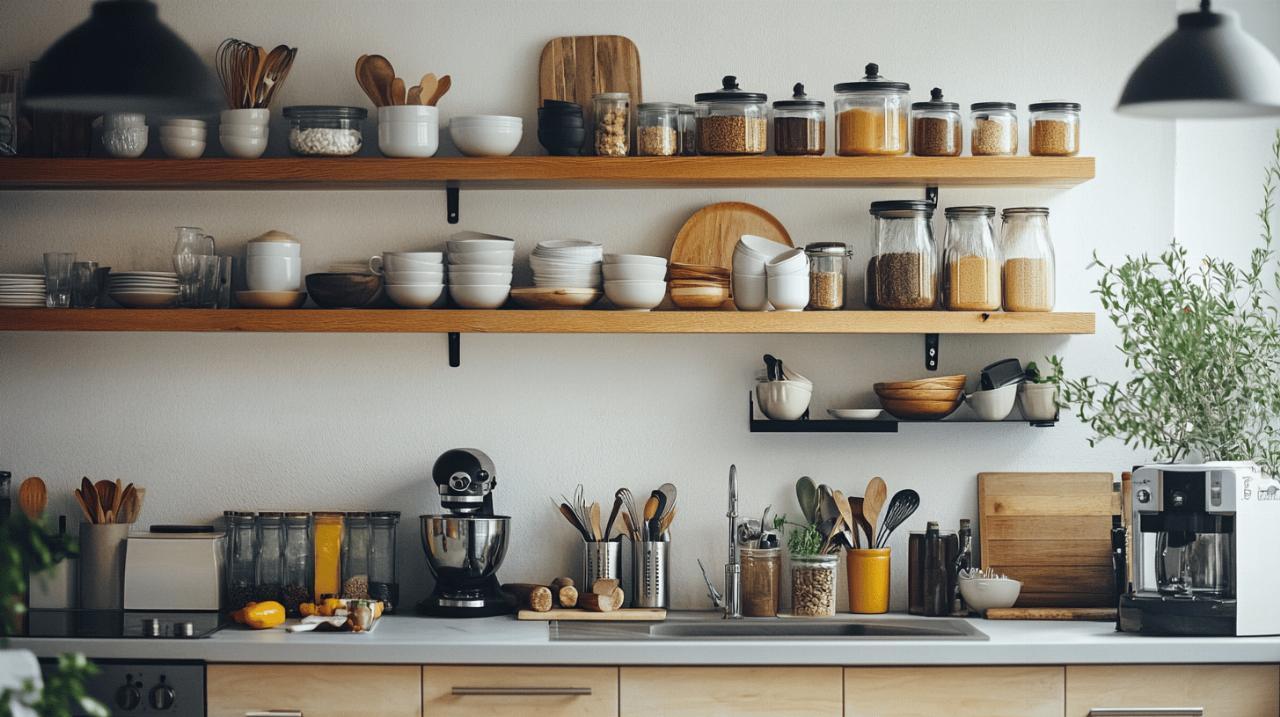Embarking on a kitchen organization journey can revolutionize not only the functionality of your space but also enhance your daily cooking experiences. Whether you have a compact galley kitchen or a spacious culinary domain, implementing strategic organization techniques can make a world of difference.
Smart storage solutions
Transforming your kitchen starts with intelligent storage strategies that maximize every inch of available space. By rethinking how you utilize your kitchen’s layout, you can create a more efficient environment for meal preparation and cooking activities.
Utilizing vertical space
Often overlooked, vertical space offers tremendous potential for expanding storage capacity. Installing floating shelves or hanging racks on empty wall areas can provide additional room for frequently used items. Wall-mounted magnetic knife strips free up valuable counter space while keeping essential tools within arm’s reach. The space above cabinets can house decorative items or seasonal serving pieces. Many kitchen enthusiasts create a Monkey Garden effect with hanging planters for herbs, adding both functionality and aesthetic appeal to previously unused vertical zones.
Drawer dividers and organizers
Cluttered drawers quickly become inefficient catch-all spaces where items disappear. Implementing drawer dividers transforms these chaotic areas into orderly storage systems. Customizable organizers allow for precise separation of utensils, cooking tools, and gadgets. Adjustable dividers can accommodate various item sizes while maximizing drawer capacity. Clear organizers make identifying contents effortless, reducing time spent searching for specific tools. Consider categorizing items by function rather than size for a more intuitive arrangement that supports your cooking workflow.
Efficient work zones
 Creating efficient work zones is the foundation of a well-organized kitchen. By dividing your kitchen into functional areas, you can maximize productivity and make cooking more enjoyable. Professional organizers recommend emptying your kitchen completely before reorganizing to create a clean slate and make unbiased storage decisions. This approach is particularly valuable in small kitchens under 500 square feet, where every inch matters. Begin by sorting your kitchen items into categories—keep, toss, and donate—to eliminate duplicates and items you no longer need.
Creating efficient work zones is the foundation of a well-organized kitchen. By dividing your kitchen into functional areas, you can maximize productivity and make cooking more enjoyable. Professional organizers recommend emptying your kitchen completely before reorganizing to create a clean slate and make unbiased storage decisions. This approach is particularly valuable in small kitchens under 500 square feet, where every inch matters. Begin by sorting your kitchen items into categories—keep, toss, and donate—to eliminate duplicates and items you no longer need.
Strategic appliance placement
Smart appliance placement is crucial for kitchen functionality. Position frequently used appliances like coffee makers and toasters within easy reach on countertops. Store seasonal or rarely used appliances in cabinets or pantry spaces. When selecting kitchen appliances, consider their size relative to your available space—this is especially important in smaller kitchens where countertop real estate is precious. Create dedicated zones for different cooking activities, placing appliances near where they’ll be used. For instance, keep your blender near your prep area and your toaster near your breakfast essentials. During your organizing process, be realistic about which appliances you actually use—many home organizers find that letting go of seldom-used items like juicers creates valuable space for everyday necessities.
Prep area optimization
A well-designed prep area streamlines cooking and makes meal preparation more efficient. Designate a specific counter space for food preparation, ideally between your sink and stove. Use drawer dividers and organizers to keep utensils neatly arranged and easily accessible. Maximize vertical space by installing hooks under cabinets for hanging frequently used tools. Consider adding cutting board organizers or knife blocks to keep these essential items within reach while cooking. For small kitchens, look into collapsible or multi-purpose prep tools that can be easily stored when not in use. Storage solutions like drawer liners, dividers, and risers help maximize space utilization. The sorting process might feel challenging, but removing chipped bowls, expired food, and duplicates significantly improves kitchen functionality. When organizing, place frequently used items at eye level and reserve higher or lower storage areas for seasonal or special-occasion items.
